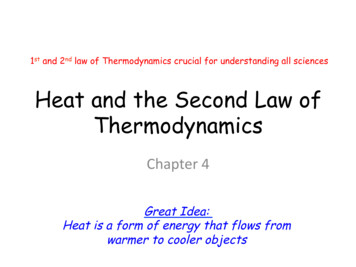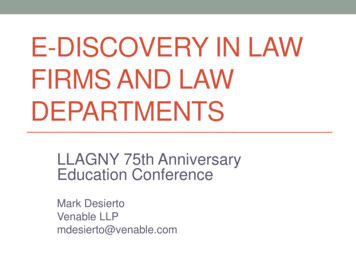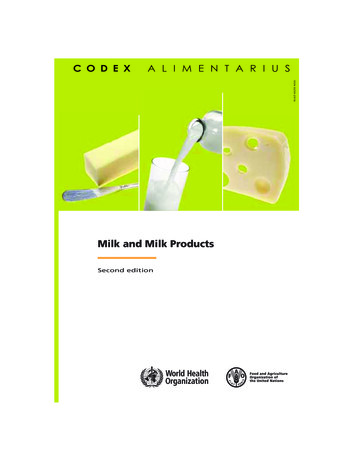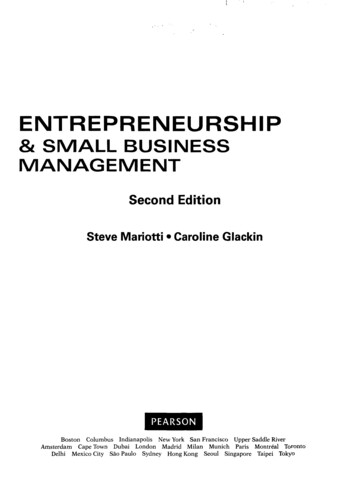
Transcription
1st and 2nd law of Thermodynamics crucial for understanding all sciencesHeat and the Second Law ofThermodynamicsChapter4Great Idea:Heat is a form of energy that flows fromwarmer to cooler objects
Chapter Outline Natureʼs DirectionComing to Terms with HeatHeat TransferThe Second Law of ThermodynamicsConsequences of the Second Law
Natureʼs Direction
SecondLawofThermodynamics
Coming to Terms with Heat
Heat and Temperature Heat– Energy in motion– Warm to cool Temperature– Atomic movement Temperature Scales– Fahrenheit scale– Celsius– Kelvin Absolute zero
ComparisonofTemperatureScales
Temperature Conversions Conversion to Fahrenheit:– F (1.8 x C) 32 Conversion to Celsius:– C ( F – 32)/1.8
Specific Heat Capacity Specific heat capacity– Quantity of heat needed to raise 1g of asubstance by 1 C Water– Highest specific heat– 1 cal/g C
Heat Transfer
Heat Transfer Conduction– Movement of heat by atomic-scale collision– Thermal conductivity Convection– Bulk transfer of molecules– Convection cell Radiation
Conduc9on
Infrared Imaging DetectsHeat Loss
Convec9on
Technology Home Insulation
The Science of Life Animal Insulation and Feathers
The Science of Life Temperature Regulation
The Second Law ofThermodynamics
The Second Law ofThermodynamics– Heat does not flow spontaneously from cold to hot– No engine can exclusively convert heat to work– Every isolated system tends toward disorder
Heat Will Not Flow Spontaneouslyfrom a Coldto a Hot BodyCan you do it?
Efficiency of an Engine Determined by the second law ofthermodynamics
Every Isolated System BecomesMore Disordered with Time Ordered System– Regular predictable pattern Disordered System– Random Entropy– Measure of disorder– The entropy of an isolated system remainsconstant or increases
Highly Ordered Regular vs.Disordered Patterns
Consequences of theSecond Law
The Arrow of Time Four dimensions– 3 have no directionality– The 4th has direction Time– Second law and time
Built-in Limitationsof the Universe The Second Lawʼs consequences– Some things cannot happen– Fossil fuels– Hierarchy of energy
The Science of Life Evolution and the Second Law ofThermodynamics
Let’s go back to Energy .How do we get energy from fossil fuels?One example .ThinkQuest
How Do Fossil Fuels and Biomass Pollute?All fossil fuels and biomasses consist of carbon and hydrogen atoms.When these fuels are burned, or "combusted," carbon atoms unite with oxygen inthe air to form carbon dioxide.
Energy content of various fuels:Energy from fuelsDirect heat, lightingRun an engine .Heat, Other workUnitofenergyisJoules
What is the problem?EfficiencyEngines:Efficiency work done/energy put into the system What you got out/What you put in100% efficiency not possible .friction, viscosityinsulationotherA heat engine is a physical or theoretical device that converts thermal energyto mechanical output. The mechanical output is called work, and the thermal energyinput is called heat.
Think of an engine as operating between two thermal reservoirs One at High Temperature engine takes the heat (QH from hot reservoirdoes work with it and returns the rest to the cooler reservoir Energy Conservation . QH Work QCIf you want engine to operate you must provide QHEfficiency W/QH
No perfect engines .We can only convert some of the heat to worknot all of it 2nd Law of Thermodynamics Entropy Time Travel “Beam me up Scotty” . “perfume “
Example: In the US, 85% of the electricity isgenerated by burning fossil fuels to produce steam,Which in turn drives alternators that produceelectricity. Power plants can produce steam with atemperature as high as 6000C by pressurizing thesteam. The resulting waste heat must be exhaustedinto the environment at a temperature of 200 C(1- Tcold/Thot)x 100% maximum efficiency600 273 873 degree Kelvin20 273 2931-(293/873) x 100% 66.4%Real power plants .40%
So what does this mean for energy?Electricity is a manufactured product. It is notsomething you pump out of the ground or mine orcollect from the sun or wind.Electric power is manufactured from a rotatingmachine that we call an electrical generator. Afterit is generated, (manufactured) it is then deliveredthrough copper wires to where it is utilized
But the invention of the machineto generate power is right nextto the invention of the printingpress in the list of majorcontributions to the advancementof human civilization.
A "generator" and "motor" are essentially the samething: what you call it depends on whether electricityis going into the unit or coming out of it.Electric generators are essentially very large quantities ofcopper wire spinning around inside very large magnets, at veryhigh speeds.Example: A commercial utility electric generator -- for example,a 180-megawatt generator -- can be quite large.It is 20 feet in diameter, 50 feet long, and weighs over 50 tons.The copper coils (called the "armature") spin at 3600revolutions per minute. Although the principle is simple (copperwire and magnets), it's not necessarily easy!Steam turbine generators, gas turbine generators, diesel enginegenerators, alternate energy systems (except photovoltaics),even nuclear power plants all operate on the same principle magnets plus copper wire plus motion equals electric current.The electricity produced is the same, regardless of source.
A heat engine is a physical or theoretical device that converts thermal energy to mechanical output. The mechanical output is called work, and the thermal energy input is called heat. 100% efficiency not possible . friction, viscosity insulation other . Think of an engine as operating between two thermal reservoirs One at High Temperature engine takes the heat (Q H from hot reservoir .











